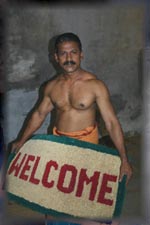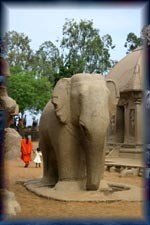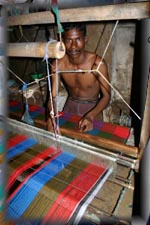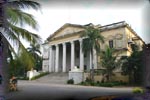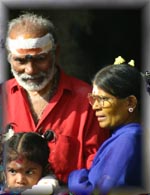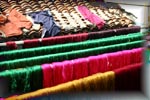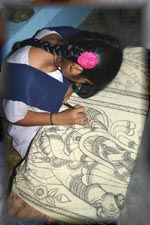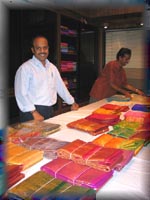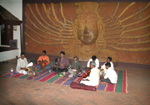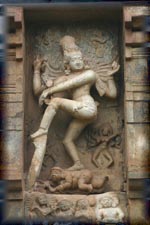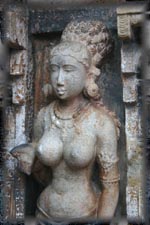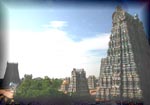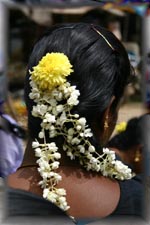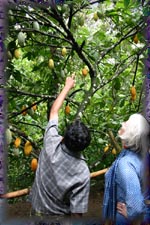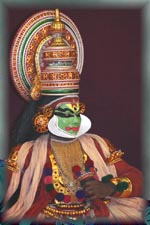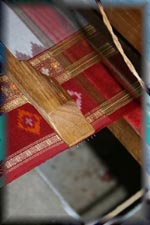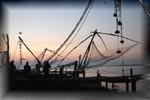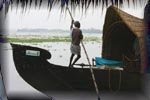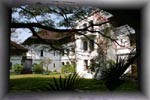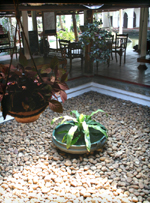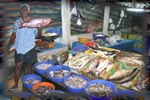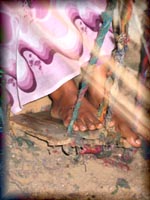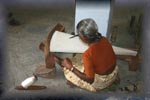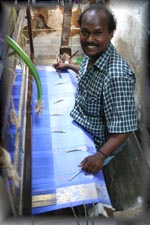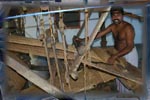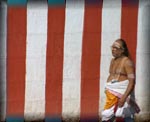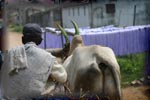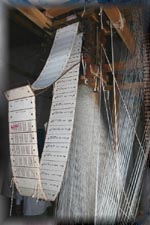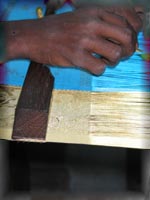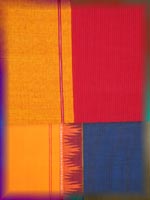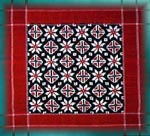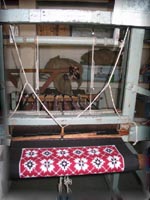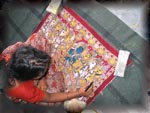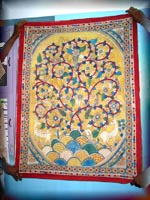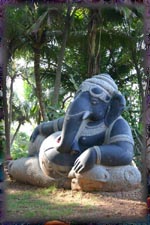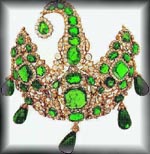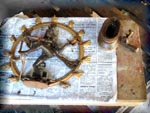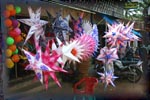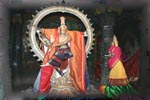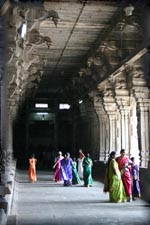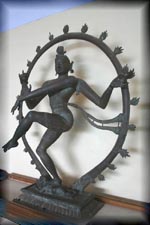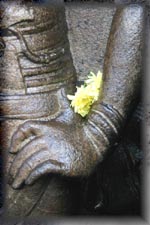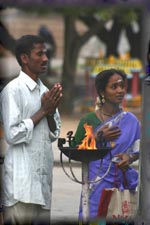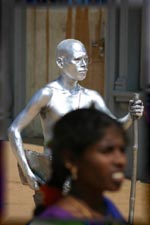 or
many years we have take tours to the north of India. These tours focused on
the history and architecture with a special emphasis on crafts and textiles.
or
many years we have take tours to the north of India. These tours focused on
the history and architecture with a special emphasis on crafts and textiles.
Over time we established relationships with particular
craftspeople so that to return every two years was like re-visiting old friends.
Many clients who travelled with us in the north
requested that we develop a similar tour to the Indian south. The Silk and
Spice tour is our response. It explores the South Indian states of Andhara
Pradesh, Tamil Nadu and Kerala. It is a tour of the most interesting textiles
and crafts, the most entertaining sights and the best hotels to lay our heads.
Silk and Spice captures the feel and flavour of this very different region.
We run only a few tours each year. In order to
maintain the quality of the experience, the numbers on each tour are limited.
Because they are different, the tours frequently sell by word of mouth. That's
great as friends are always the best travelling companions. As of this date
there are only limited spaces available for this tour. If you are interested,
please email your request.
for a place.

THE
GENERAL PLAN
 rom
Auckland we fly with Thai International to Bangkok. for an overnight stay.
Next morning we fly on to Chennai - which is no longer known as Madras - except
by most of the people who live there! It's a two hour drive to Mamammalapuram
on the Malabar coast. There is time to visit Dakshina Chitra, a village
complex displaying the building styles of different southern regions, also
(a departure from the usual 'Footprints experience') a visit to the largest
snake-farm in the world!
rom
Auckland we fly with Thai International to Bangkok. for an overnight stay.
Next morning we fly on to Chennai - which is no longer known as Madras - except
by most of the people who live there! It's a two hour drive to Mamammalapuram
on the Malabar coast. There is time to visit Dakshina Chitra, a village
complex displaying the building styles of different southern regions, also
(a departure from the usual 'Footprints experience') a visit to the largest
snake-farm in the world!
|
|
|
Pancha Pandava Rathas
c650 CE Mammalapuram
|
Here they make vaccines for use throughout SE Asia and
breed crocodiles for restoration to the wild.
|
|
|
Cotton weaver
Tirukalikundram
|
We have two nights in the Mammalapuram area. The town is justly
famous for wall-sized carvings which celebrate the Pallava kings of Kanchipuram.
During the 5th to 8th centuries Mammalapuram was the port and temple town
for this Tamil dynasty. At the nearby town of Tirukalikundram we experience
our first working-temple and visit the town's cotton weavers. Their checkered
pattern lungis are prized throughout the south.
From Chennai we fly to Hyderabad, India's sixth largest city.
Situated in the middle of the stony Deccan plateau it was host to some of
the world's wealthiest rulers. Successive Nizams indulged their taste in pearls
to make this the 'only' city in India for modern barons to buy some extra
strings. You will have a chance to join them! In former times, it was home
to some of the world's greatest diamonds which came from the the great mines
of Golconda. The Weaver Service Centre and store, support
and display traditional offerings from the looms of Andhra Pradesh.
|
|
|
The Residency, Hyderabad
|
 |
|
James Achilles Kirkpatrick
|
Stylish and innovative creations are on show at the workshop
of Bina Rao, one of India's leading designers. We pay a visit of homage to
The Residency. Now a 'Ladies College' it was constructed in the 18th century
home as the residence of James Archilles Kirkpatrick. The first Resident of
the East India Company, his life, home and extraordinary marriage are the
focus of William Dalrymple's 'White Mughals' - a great read!
|
|
|
Shaivite family
Sri Kalahasthi
|
Hyderabad is a teeming city, not noted for its charm. For
fun, and to be better located, shall spend two nights at the Ramoji Film Studio.
Set in the countryside outside the city it is the south's answer to Bollywood
and the biggest producer of Telugu speaking movies in the world. There is
a great hotel where we spend two nights. Ramoji is close to a scattering of
weaving villages that we shall visit. Working with either silk or cotton,
using complex Jacquard-type looms they produce glorious fabrics.
On the principle that no Indian visit is complete without
a train trip, we shall take an overnight train from Hyderabad to the southern
edge of Andhara Pradesh and the tiny town of Sri Kalahasthi. In 05 and againe
in 06 we will be the largest-ever European groups to arrive in this charming
town by train. We have come to visit its notable Shiva temple and the nearby
masters of kalamkari painting. This art was developed to serve the needs of
temples and of royalty. Using a charred stick, the designs are painted directly
onto cotton. Traded into Europe, its Tamil name cheeti, gave origin to the
term chintz -European printed cloth. An hour's drive north is the cotton weaving
village of Venkatagiri. Their fame is the production of superfine cotton saris
with a zari border. Zari is gold or silver coated thread. Woven into the border,
or sometimes the body of a piece it can be glitzy or stunning!
|
|
|
Silk yarn drying
Venkatagiri
|
|
|
|
Kalamkari painter
Sri Kalahasthi
|
Tirupati, where we stop for the night, is the world's busiest pilgrimage town.
Far more come here in search of spiritual communion than to Mecca, Rome or
Jerusalem combined! And, in a nation of religious excess, the main temple,
on a high ridge twenty kilometers out of town, boasts the single most expensive
object in the world - a diamond crown on its principal lingam. As non-Hindus
we are not permitted to view this wonder but two small temples in the town
give a flavour of the pilgrim's way. At both Tirchanur-Padmavati and Kapilesvaraswami
pearls, diamonds and rubies are abundant! There are fine images and much,
much smaller crowds.
It's a pretty drive through steep, red-cliffed hills to
Kanchipuram.
|
|
|
Mr M Ponnusamy
mechanical engineer
turned silk dealer
Kanchipuram
|
By universal acknowledgement this town produces the finest
silk 'wedding saris' in India. Their designers and weavers have been doing
this for centuries - to justifiable acclaim. Outside our hotel, on Mettu street,
are a string of comfortable emporia where matrons and daughters flock from
all over India to compare, to feel and to buy. We visit the village of Pillayar
Pallayam and the homes of weavers who create this glory. Their forefathers
are remembered at the museum of folk art, a four hundred year old house with
a wonderful collection of old saris. The grand Ekambareshvara temple commemorates
the wedding of Parvati and Shiva, who celebrated their nuptials here 3,500
years ago, under a still-present mangoe tree. The high stone colonnades of
this 16th century temple are shaded, cool and a pleasant place to wander.
Nine hundred years earlier the Pallava dynasty built the much simpler, but
in many ways more impressive, Kailasnatha temple. The sandstone carvings here
graceful, human. And, like so much in south Indian art they display a degree
of sensuality that so offended the Victorian English.
|
|
|
musicians
Sterling Swamimalai
|
For hundreds of kilometers, a watery expanse of paddy-field
and coconut palms underpin the historical wealth of this region - a wealth
which attracted conquerors and traders throughout the centuries. At Pondicherry
you will be reminded of French colonial times by the red topees, still worn
by local cops and the charming old stone buildings. There are excellent restaurants,
quality antique shops and the cool courtyards of the 250 year old Hotel d'Pondicherry.
The nearby community of Auroville was founded by the late 20th century mystic
Sri Aurobindo. Today the community runs some of the finest craft workshops
in all South India.
The great fertility of the Kaveri valley and the skill of
its farmers contributed to the fortunes of many southern dynasties. Chidambaram
is one of the holiest towns in India. The great cosmic dance of Lord Shiva
- Shiva Natraj - was celebrated here in stone by the Chola dynasty. It was
here, from the 9th to 11th centuries that the huge temple of Sabhanayaka Natraja
arose, and was decorated with superb carvings. Nearby at Swamimalai, the bronze
statues which celebrate Lord Shiva's dance are still being crafted, poured
and hammered into life. A thousand year heritage.
|
|
Shiva Natraj
Chola period ca 700 CE
Gangaikondacholapuram
|
We shall see other examples of great Chola work in the temple
of Gangaikondacholapuram, and the sensuous temple maidens of Nageshwara Swami
Shiva are guaranteed to capture your heart. These statues are without peer.
Truely "..the finest surviving pieces of stone sculpture in South India".
|
|
|
Chola maiden
Nageshwara Swami Shiva t.
ca 900 CE Kumbakonam
|
When the Cholas controlled most of South India their capital
was Thanjavur. Here they built another great temple, one of the few with World
Heritage status. Brihadishwara used to have four hundred devadasi (temple
dancers). The only ones which remain are in stone.

|
|
|
Palace Courtyard
Chettinad
|
In the 19th and 20th centuries, the menfolk of Chettinad
district became the bankers and moneylenders to the subjects of British
Burma. It was profitable trade as they returned home with shiploads of teak
and sufficient cash to create several score of stylish palaces. The Bangala
at Karikodi is a delightful Heritage property run by Meenakshi Meyyapan,
a descendent of one banking family. We shall have two nights to enjoy her
company, visit homes and a variety of local craft-workshops. In the region
are distinctive weavers, coppersmiths, goldsmiths and - for a change of
pace - quite, quite lovely concrete tiles!
When seen from a distance, the huge granite outcrops around
Madurai, resemble browsing dinosaurs. We shall stop at one granite quarry
to speculate on how many years it will take to make level. Strabo, the Roman
geographer, complained that the silks, spices and pearls of Madurai were
draining the Empire's resources. For a thousand years, without interruption,
it was capital of the Pandyan empire, and undoubtedly an important place.
Now, on an average day, more than 15,000 people come to pay homage at the
impressive Meenakshi-Sundareshwara temple.
|
|
|
Meenakshi-Sundareshwara
Maduri
|
When raided by the Delhi Sultanate in the 13th century the
booty consisted of "..six hundred and twelve elephants, ninety-six
mans of gold, several boxes of jewels and pearls and twenty thousand horses".
Estimates as to the size of 'man' in those times vary. So it is difficult
to gauge the quantity of gold. However, one authority suggests that at that
time a 'man' was about 25 pounds - about 2400kg for this raid alone! [thanks
to Peter Win for the opinion about size of a 'man'. ] Suffice to say that
Madurai and other temples of the south were very, very rich - and a lot less
so after the visit of Malik Kafur from Delhi! Our visit will contribute only
slightly to temple coffers!

For two thousand kilometers the western edge of the Indian
peninsula is tipped steeply skywards. These mountains, the Western Ghats,
or steps, separate the dry central plateau from a narrow, well-watered coastal
strip. We pass through the Cardamom hills, leaving
the state of Tamil Nadu for Kerala. These highlands have long been a major
source of highly prized spices -pepper, cardamom, cinnamon, vanilla, ginger,
allspice, turmeric and nutmeg. In Periyar we stay at the aptly named Spice
Village Hotel and take time to visit a commercial spice garden and a tea
estate. The damp tropical rainforest of the Periyar Wildlife Sanctuary is
home to wild gaur, deer and elephant.
With luck we shall see all of these on a day tour into the
park.
Kerala is the most Christian state in India. From very early
in the Christian era successive groups of Christian denominations have made
their mark here.
|
|
|
Sister Elizabeth
at Brunton Boatyard Hotel
|
At Pallai is a charming 16th century Syrian-Christian church
with restrained European style frescoes of high quality and an exuberant altar
surround that speaks more of India. The local convent crafts high quality
needle-work onto the finest of white cotton. Frescoe painting in Kerala has
an exhuberant and unique style. Ettumanur temple has vigorous examples of
Lord Shiva in a less-than-happy mode!
Along small waterways, near our Kumarakom Lake Resort, you
can view village life, and the home of Arundhati Roy, whose 'God of Small
Things' is based on life hereabouts. From the hotel lake we set out for an
overnight kettu vallum cruise. These comfortable bamboo-thatched craft
provide a comfortable and enchanting mode of travel across Vembanad lake to
Alappuzha. Under its former name, Alleppey, this was one of the most important
ports on the Malabar coast. It is also the center of Kerala's coir industry.
The rough fibre of the coconut is combed, woven, thumped and pressed into
an astonishing range of products.
|
|
|
Kathakali Dancer
Fort Cochin
|
The greatest of all trading ports was Cochin, modern-day
Kochi. A succession of Portuguese, Dutch and British masters competed to
control the port and its lucrative spice trade. At Fort Cochin they left
an architectural heritage that makes today's town a delight. Its a photogenic
place. Our modern hotel, and our most grand, The Brunton Boatyard celebrates
the Dutch colonial style. We visit local sites, and take time at a Kathakali
theatre to view the dancers both in performance and during their intricate
makeup routine. We head out of town to visit the bronze casters of Nadavambaram
and the cotton mushru- weavers of Chandamanglam.
|
|
Sari border detail
Ponchampalli
|
It takes an hour to fly to Chennai. This old city sprawls
along a gravel beach which functioned as 'port' for the East India Company.
For 350 years it was the economic and administrative capital of the south.
We have two nights here. More than enough time for a city tour; to visit the
Government Museum -with its stunning collection of marble sculptures from
Amaravati; to explore some classy shops; and to take afternoon tea at the
Taj Connemara. - a stylish relic of the Raj. One at a time, and only one at
a time (!) we shall experience one of the world's most remarkable bookshops,
'Giggles'!
A late night departure takes us to Bangkok for a day-sleep,
then on to New Zealand.
|
|
|
Chinese fishing nets
Fort Cochin
|

 THE
HOTELS
THE
HOTELS
 ll
our hotels are selected for the best combination of character, location and
price. Many are charming. A few have an eccentric edge, like Tara Ramoji.
Set amidst the rocky hills of a huge
outdoor film studio it boasts four star accommodation and some wonderful examples
of Indian brassy kitsch!
ll
our hotels are selected for the best combination of character, location and
price. Many are charming. A few have an eccentric edge, like Tara Ramoji.
Set amidst the rocky hills of a huge
outdoor film studio it boasts four star accommodation and some wonderful examples
of Indian brassy kitsch!
|
|
|
Brunton Boatyard
Fort Cochin
|
In contrast, the Hotel d'Pondicherry
in Pondicherry has the restrained grace of an older lady, with Gallic
style. Sterling Swamimalai has the feel of a rural south, an Indian
family home, with a series of bungalows grouped around interlinking courtyards.
The Bangala is more English, another family home charmingly intimate,
with superb food. Kumarakom Lake Resort is a collection of old Keralan
homes reborn as a very stylish modern resort. Spice
Village by contrast, is a group of well appointed thatched bungalows surrounded
by the gardens which explains its name. Its modern,
planned and impressive. Each kettu vallam has two en-suite bedrooms
and a 'planters' lounge.
Definitely the most romantic way
to cruise the waterways of Kerala. Brunton Boatyard is big and grand,
a 'Queen Mary' by comparison. Built on the site of an old boatyard it has
a spare, Dutch style and real class.

 and
the FOOD
and
the FOOD
 outhern
food is quite wonderful. The gastronomic delights of this tour happen on
a daily basis - almost without planning - and are indeed one of the trips
special features. 'Unplanned' in the sense that really 'great' food is very
much the everyday experience in this part of the world. Southern food
has a reputation of being fiercesomly 'hot', but this is simply not true.
In general meat dishes are quite hot-spicy but the vegetarian fare, for
which the region is noted, is mild.
outhern
food is quite wonderful. The gastronomic delights of this tour happen on
a daily basis - almost without planning - and are indeed one of the trips
special features. 'Unplanned' in the sense that really 'great' food is very
much the everyday experience in this part of the world. Southern food
has a reputation of being fiercesomly 'hot', but this is simply not true.
In general meat dishes are quite hot-spicy but the vegetarian fare, for
which the region is noted, is mild.
|
|
|
Cooking demonstration
Spice Village Hotel
Periyar
|
The South is indeed vegetarian heaven. Because
Hinduism is so all pervasive here, the religion's admonitions towards the
vegetarian way are generally accepted. For several millenia the region's chefs
have taken the plenitude of this rich earth to craft great vegetarian dishes.
Even the most rabid enthusiast for the T-bone-way will find their palate stimulated
and, there are always plenty of meat and fish dishes for those who wish.
For those who enjoy creating food, Spice
Village arranges a cooking demonstration each evening. And their 'Celebration
of Spices' cookbook is a must-buy.


the
TEXTILES and CRAFTS
 ince
the third milleneum BCE the peoples of India have been producing brightly
coloured, naturally dyed fabrics that were fade-resistant. In the beginning,
it was patronage from wealthy rulers and temples which enabled particular
regions to develop their crafts. The development
of regional and international trade enhanced this business, enabling many
to flourish.
ince
the third milleneum BCE the peoples of India have been producing brightly
coloured, naturally dyed fabrics that were fade-resistant. In the beginning,
it was patronage from wealthy rulers and temples which enabled particular
regions to develop their crafts. The development
of regional and international trade enhanced this business, enabling many
to flourish.
With textiles, Indian
cloth became much coveted by the early Persians, Greeks and other Europeans
because of its brilliant colours. It was not until the 17th century that
the knowledge of how to produce such colours was understood in the west.
Hence, a flourishing trade developed that for centuries ran in favour of
India.
It was this transfer of funds that contributed
to the fabulous wealth of Indian merchants and rulers in the south and west.
Despite enormous distances and difficulties of communication a system developed
that allowed village crafts-people to produce specific wares to satisfy
the tastes of foreign clients thousands of miles away. It was this flexibility
associated, almost pradoxically, with strong craft and caste traditions
that enabled them to survive the near death-blow development of aniline
dyes and mechanised looms in the west
and to retain a reputation which persists to this day. That, and the rise
of a discerning Indian middle class has led to demand for hand-crafted product.
|
|
|
|
Creating silk warp
Venkatagiri
|
Villages that supplied the great kingdoms of South
India a thousand years ago, still craft their traditional work.
Skilled craftspeople were, and
still are, highly valued so that any visit to India is enriched
by exploring the crafts available. Down narrow lanes in every village
craftsmen and women still practice ancient arts handed down from
generation to generation
We take a personal delight in the region's crafts
and on this trip will explore further the villages and craftspeople
who make this magic possible.We have researched
the best local guides, the most appropriate villages and which museums
and crafts people to visit. The focus is on the regions textiles
but we shall not neglect other crafts and sights.
What's listed here is only a tiny sample of the
myriad gems awaiting the discerning traveller.
And, if your heart desires a two metre statue of Lord
Shiva we shall find just the right place for you to shop!
|
|
|
|
Snappy-dressing
from the middle class
Ekambareshvara Temple
Kanchipuram
|
WOVEN CLOTHS:
Throughout India more than ten million people are dependent for their livelihood
on the handloom industry. The skills of these village communities have been
enhanced by the establishment of Weaver Service Centres which provide
professional marketing, dying and design techniques. We shall visit one centre
in Hyderabad. It is however the adaptability of those village dyers and weavers
that has enabled them to respond to the demands of a world market and a burgeoning
Indian middle class.
SILKS: On this
tour there are two major regions noted for their silks - around Hyderabad
and around Kanchipuram. Pure silk sarees are in demand across all strata
of Indian society. Traditionally for Brahmin women they were regarded as
essential, since silk is the only material regarded as pure and hence suitable
to wear during the daily puja to the household deity and for the
preparation of food. .
Hyderabad region: We
shall be visiting four villages east of Hyderabad. They are small and friendly,
with almost every home involved in the textile business. Side streets are
draped with long bands of warp as part of the loom setup process. Kids play,
cows wander and dyeing vats bubble. It is very photogenic. At Ponchampalli
they produce fine silk sarees as well as cotton ikat (tie-dye).
At Choutappal the silk sarees have complex borders
created with Jacquard looms. While the looms of Putta Pakka deal with
single ikat silk-yardage and silk dupattas. Many weavers in Putta Pakka
work for a single trader in Hyderabad, Mr G. Govardhana. At his Hyderabad
shop we shall see how he has adapted local designs for Western and Japanese
markets. Within the village differing styles are presented at the emporium
of Mr Gajam Ramesh and we hope to visit the home of a National Award winning
weaver Mr Gajam Anjaiah.

|
|
|
Silk Saree border
Kanchipuram
|
Kanchipuram region: Since
ancient times Kanchipuram has been an important religious and political
centre. Weaving skills here matured at a very early date as numerous literary
texts attest. In the 20th century the weavers of Kanchipuram achieved national
fame for their production of silk saris notable for their rich appearance,
drape and durability.
The main production is of brocaded silk saris, often with
the palav (endpiece) and borders in a contrasting colour to the main
body of the garment. The natural silk comes from the Bangalore area which
has ideal conditions for rearing mulberry silk worms and the zari (gold
or silver wrapped thread) from Surat in Gujerat.
|
|
|
Silk weaver
Pillayar Pallayam
[note the finger-nail]
|
The village of Pillayar Pallayam has numerous silk weaving workshops.
The weavers sit at groud level using their pit looms and throw shuttles to
create the most sumptuous fabrics. Often, to save space, two looms are mounted
one above the other in the same room creating a three dimensional presentation
of their art.

COTTONS: Throughout
the south, woven cottons are in more widespread production than silk. From
the start of our tour in the small town of Tirukalikundram; through the
Andhra Pradesh villages around Hyderabad; to the pretty town of Venkatagiri;
and the Keralan village of Chandamangalam we shall be enveloped with stunning
cottons. We will visit the creators of this glory.
|
|
|
Cotton lungi
Koyyalagudem
|
The variety of texture and design is extraordinary.
In texture - from the heavy ikat bedspreads of Putta Pakka to the most
sheer '120/120' muslins of Kerala's karalkudi sarees.
In colour - from the bright checks of Karaikkuti and the moonbeam whites
of Kerala to the broad stripes of Chandamangalam mushru. It is all
overwhelmingly extraordinary!
Kerala is noted for sheer, fine, white cotton saris with
a narrow plain-coloured border without decoration. Around Chandamanagalam
though, an hour's drive from Kochi, a group of Moslem weavers create attractive
checked patterns of cotton yardage and a type of mushru in cotton
and satin (silk-cotton combination thread).

|
|
|
'Telia Rumal' ikat
Putta Pakka
|
IKAT CLOTHS:
Telia Rumal is a square double-ikat
head or loin cloth first developed in Andhra Pradesh about a hundred years
ago. ('Telia' refers to the oily smell left after the use of alizarin dyes
and 'Rumal' means square or kerchief.) As head cloths they were once very
popular in Bangaldesh, Pakistan and north Africa. Today the market is entirely
domestic.
|
|
|
Telia Rumal
loom
Weaver Service Centre
Hyderabad
|
Once learned the tie-dye techiques were applied
to weaving of saris, dupattas (scarf) and yardage. This recent diversification
from sari to yardage production and the development of international markets
has completely transformed the design perspective. Freed from traditional
rumal or sari requirements weavers and designers have combined to create items
with wide appeal to international and urban consumers. We shall see these
designs and techiques in Ponchampalli and at Putta Pakka, as
well as a wide range at the Murali Saree Emporium, the shop of Mr G Govardhana.

|
|
|
Traditional kalamkari
Sri Kalahasthi
|
PAINTED CLOTH: Painting
cotton with luminous permanent dyes was probably first developed in Southern
India. Court and temple patrons commissioned artists to paint designs using
a wooden stylus, or kalam. In a complex process, using a succession
of mordants, dyes and wax-resist they created what we would now call works
of art. Kalamkari 'pen-work' in its purest form is now
carried on only at Kalahasthi, where the cotton is decorated entirely
by the freehand use of the kalam.
|
|
|
Tree of Life -
Contemporary kalamkari
Sri Kalahasthi
|
Long before European traders intruded, in the 15th and 16th
centuries, the main market for these painted textiles of the Coramandal coast
was the spice region of South East Asia - now known as Malayasia, Indonesia
and the Philippines. Portuguese and Dutch spice traders quickly discovered
that these people wanted Indian textiles rather than the precious metals they
had hoped to exchange for spices. Consequently the Europeans used their gold
and silver to purchase textiles from the Indian south-east to exchange for
spices. Although printed and painted Indian cottons were known in Europe from
about 1000CE the development of sea routes in search of spice let to a vastly
enhanced trade in Indian textiles.
By the 17th and 18th centuries painted and printed cloths,
known in the trade as chintz, (from the Hindi word for 'variegated'
) were produced in their thousands. The most popular design for European
export was the 'tree of life', a unique amalgam of Indian, Chinese and European
influences. Mechanical looms dealt a severe blow to the European trade and
with development of block printing the freehand techique of kalamkari
almost died out in the 20th century.
In the 1950s the All India Handicrafts Board rejuvenated
the techique in Kalahasthi where it gently hangs on. At Kalahasthi today,
the designs are mostly figurative - religious works which appeal to the
accustomed eye. However they continue to paint life's great tree and there
remain a few masters and workshops who say that business is improving. I
hope our visit helps.

|
|
|
Something for your garden!
Lord Ganesh
from Mammalapuram
|
STONE CARVING: There
is a long tradition of stone sculpture in the south. The Buddhist cave temples
of the 4th-3rd centuries BCE culminated in the sublime sculptures of Amaravati.
(now in the Chennai museum) When Buddhism was supplanted, these passed-on
skills were used to decorate the great temples of the Pallava and Chola
dynasties. We will experience this stonecarving skill and industry in the
thriving beachside workshops of Mammalapuram. Accomplished as their
forefathers, they ship all over the world and can work from a photo. So...
if you'd like a bust of Jesus, or your favourite spouse, this is the place
to come!

JEWELLERY - Diamonds:
Sometime around 1653, the greatest of all diamonds, the Koh i Noor, was
taken from the Kollur mine near Hyderabad. The Golconda region had been
producing most of India's diamonds for centuries. This fecundity generated
great wealth and a host of diamond cutters, goldsmiths and merchants. These
Golconda mines were the sole suppliers of diamonds to the world till the
beginning of the 18th century, when diamonds were discovered for the first
time in Brazil. Successive rulers of Hyderabad added to the palace collection,
making the last Nizam, reputedly the richest man in the world.
Nowadays the mines are exhausted but the Indian diamond business continues
to thrive: nine out of every ten of the world's diamonds are processed in
India, often Gujerat; diamonds are India's single biggest export (really
re-export); about a million people are employed in the trade! Given this
history, it is not unusual that the skills of
|
|
|
Emerald & Diamond
turban clip
Nizam of Hyderabad
|
Hyderabad jewellers make it a preferred destination
to browse for those glassy baubles.
& Pearls: All jewels were desirable
to the Nizam. Initially pearls were brought from the Arabian Gulf. The skills
and trade which sprung up were fueled by the purchasing power of the Moghul
emperors to the north. And this demand has continued to be flamed by the
modern barons of Indian industry. So, despite being far from the coast,
it is still a great place to shop for pearls.
& Emeralds: If you want to add a bit
of colour, and contemplate turning your wealth to stone, consider the emerald!
Although India imported emeralds from Cleopatra's mine in Egypt for thousands
of years and the fabulous gems in the collections of the Maharajahs mostly
come from the mines of Colombia via Spain, there are carats of more modern
ones in the jewel bazaars.
& Gold: Indians are only matched
by Chinese in their lust for the yellow metal. The smallest villages have
a goldsmith who will be delighted to discuss the latest fashion and the
current price of gold.

|
|
|
Shiva Natraj
wax model before casting
Nadavambaram
|
METALWORK: Two and a
half thousand years before Christ there were highly developed skills of
bronze casting in India. In the south the demand by temples for portable
images led to some of the most glorious of all India art - the Chola bronzes.
|
|
|
Chola bronze ca1000 CE
Government museum
Chennai
|
The Chola dynasty from 9th to 11th centuries was noted for
the quality of their bronze work. We shall see examples of these statues
in temples and museums. At Swamimalai and Nadavambaram, in
palm-thatched huts, they maintain the laborious technique of
'lost-wax'. Exquisite bronze statues are on sale and
brass and bronze items of more western appeal. Lamps, bowls and chains are
of great value and can be readily shipped home.
If your taste runs to copper-ware, the craftsmen of Karikkuti or Thanjavur
are likely to appeal.

PAPER STARS: We knew
nothing of this art form until we went first to the south. Kerala, has a
large Christian population and a tradition of religious tolerance. In general,
Indians love celebration and decoration. These celebratory circumstances
have come together in the production of paper lanterns for the Christmas
festive season. The lanterns are great for tourists as they fold flat, look
great and cost little.


SILK
and SPICE
ITINERARIES and PRICES
|
|
|
|
|
Lord Shiva & Parvati
dressed for life
Chola bronzes ca1000 CE
|
|


SILK
and SPICE,
Land only group
 hose who wish to travel elsewhere in Asia or travel
on to Europe may prefer this option.
hose who wish to travel elsewhere in Asia or travel
on to Europe may prefer this option.
Note: this option starts and ends in Chennai (Madras).
Silk and Spice 2014
|
Land Only
join & leave in Chennai
| 08Feb - 08 Mar 2014
|
|
28day trip |
|
12 nights in Heritage-type hotels |
|
first class hotels elsewhere |
|
28 days touring in A/C bus through: Andhara Pradesh,
Tamil Nadu and Kerala. |
|
admissions & camera fees to all mounuments
and museums |
|
all breakfasts |
|
5 lunches and 4 dinners not provided |
|
land & air transportation as detailed |
|
The final price for SS10 was NZ$ 13,404
note New Zealand dollars
a final price for 2014 tour will not be available until around September
2013. |
Please note: The price listed is for SS10. Final prices
for the 2014 tour will not be posted until around September 2014. I reserve
the right to make changes should major movements occur in currency or airfares.
N.B. If you choose the land-only option please organise your air travel
early. Flights to and from Asia are very heavily booked. I am happy to help
with suggestions and flight bookings if you wish.
What
shall we tell you? Tales, marvellous tales,
Of ships and stars and isles where good men rest,
Where nevermore the rose of sunset pales,
And winds and shadows fall toward the west.
The Golden Journey to Samarkand
James Elroy Flecker


 SILK
and SPICE,
MAIN GROUP ex New Zealand
SILK
and SPICE,
MAIN GROUP ex New Zealand
Silk and Spice 2014
| Main Group ex NZ
| 07 Feb - 10 Mar 2014
|
|
32 day trip |
|
1.5 nights in Bangkok |
|
12 nights in Heritage-type hotels |
|
first class hotels elsewhere |
|
28 days touring in A/C bus through: Andhara Pradesh,
Tamil Nadu and Kerala. |
|
admissions & camera fees to all monuments
and museums |
|
all breakfasts |
|
5 lunches and 4 dinners not provided |
|
land & air transportation as detailed |
|
The final price for SS10 was NZ$16,235
a final price for 2014 tour will not be available until around September
2014. |
|
ex Auckland
Different prices apply for travel from other centres
|
Please note: The price listed is for SS10. Final prices
for the 2014 tour will not be posted until around September 2014. I reserve
the right to make changes should major movements occur in currency or airfares.


 Silk
and Spice
Silk
and Spice
What do you get...and, what you don't get?
|
|
|
Ekambareshvara temple
16th century
Kanchipuram
|
For all groups
A personal introduction to some new places and interesting people with me!
· Return economy airfare from Auckland or Wellington to India· Twin-share
accommodation in all cities · Breakfasts everyday · most lunches and dinners
· A celebratory group dinner in ...I'm not sure, but somewhere nice!· Airport
transfers and departure taxes throughout · all admission and camera fees
to museums and mounuments.
What you don't get
NZ departure tax · dinner, unless mentioned · personal
insurance and medical expenses · excess baggage charges and items of a personal
nature · 5 lunches and 4 dinners. (I shall make suggestions for these)


 Is
it worth it?
Is
it worth it?
 his is a personalised tour emphasising the textiles
and crafts of South India. It has been researched to provide a very special
experience. It traverses a wide swathe of country, visiting the most important
tourist sights and staying in many unique hotels. Appropriately, for a 'spice'
tour, it enables you to savour the glories of the
south's past and present. It is deliberately not rushed.
his is a personalised tour emphasising the textiles
and crafts of South India. It has been researched to provide a very special
experience. It traverses a wide swathe of country, visiting the most important
tourist sights and staying in many unique hotels. Appropriately, for a 'spice'
tour, it enables you to savour the glories of the
south's past and present. It is deliberately not rushed.
 How many people?
How many people?
 he minimum client numbers for this tour is ten, the
maximum eighteen.
he minimum client numbers for this tour is ten, the
maximum eighteen.

 Why
go? Why
go? |
|
|
|
Shiva Natraj
Chola ca950 CE
Government Museum
Chennai
|
|
|
|
Shiva Ardashana
Chola ca930 CE
Nageshwara Swami Shiva t.
Kumbakonam
|
|
|
|
|
Meenakshi-Sudareshwara t.
Madurai
|
|
More than any place I know India
demands attention.
Coming with the privileges of affluence and education, and from a
sheltered land I rarely confront the polarities of life. In India,
such confrontation is daily, almost minute by minute. Here, in India,
is great wealth amidst appalling poverty; here, women of grace and
beauty walk through pig-swill in garments of such vivid hue that I
gasp with delight; here, vultures feast while in the same frame trees,
camels and people affirm life. And that is it for me. India affirms
life. Affirms it with an intensity that confronts my every sense.
Here life and death is immediate, revealed....demanding heed.
My favourite Indian statue is that of Lord Shiva....Shiva Natraj...Shiva
Lord of the Dance. He stands on one foot, arms outstretched, surrounded
by a halo of fire. The fire is the fire of life. Shiva invites me,
and all of us, to the dance of life. How vigorously I dance is up
to me, it is a matter of choice. For me, India increases the tempo
of life’s dance. India presents to me a vivid focus on the human
condition; a triumph in fact, of such cultural and spiritual achievement
that Lord Shiva’s flames singe me to awake. That’s my India.
John McKinnon
|
This tour is crafted to offer experiences
which are very special.
.....if this one day
in the lifetime of a hundred years is lost, will you ever get your hands
on it again?
Eihei Dogen (1200-1253)
|
|
|
a living Gandhi
Kanchipuram
|
Our tour in 2012 will be our sixth to South India.
Those who have travelled with us in the past know the quality of the 'Footprints
experience'. If you want to come on this tour please complete the form in
the 'Print' version of this page (see at the top) or, register
your interest.
If the timing of this trip does not suit,
and you would like us to arrange a tour to India for your own
independent group check out what we offer.
top of page
site map
contact us
Copyright © Footprints Tours Ltd
Programming & design by Green Kiwi Ltd
Last updated: 01aug11
e run only a few tours each year. We have many repeat clients and our trips often sell out quickly by word of mouth. Our south India tours for 2006 , 2007 and 2010 were quickly sold out.

